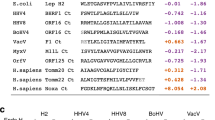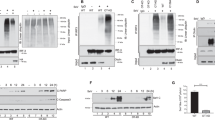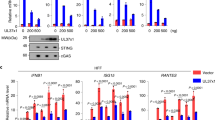Abstract
Viruses have evolved many distinct strategies to avoid the host's apoptotic response1,2. Here we describe a new family of viral inhibitors (v-FLIPs) which interfere with apoptosis signalled through death receptors3 and which are present in several γ-herpesviruses (including Kaposi's-sarcoma-associated human herpesvirus-8), as well as in the tumorigenic human molluscipoxvirus4. v-FLIPs contain two death-effector domains which interact with the adaptor protein FADD5,6, and this inhibits the recruitment and activation of the protease FLICE7,8 by the CD95 death receptor3. Cells expressing v-FLIPs are protected against apoptosis induced by CD95 or by the related death receptors TRAMP9–12 and TRAIL-R. The herpesvirus saimiri FLIP is detected late during the lytic viral replication cycle, at a time when host cells are partially protected from CD95-ligand-mediated apoptosis. Protection of virus-infected cells against death-receptor-induced apoptosis may lead to higher virus production and contribute to the persistence and oncogenicity13 of several FLIP-encoding viruses.
This is a preview of subscription content, access via your institution
Access options
Subscribe to this journal
Receive 51 print issues and online access
$199.00 per year
only $3.90 per issue
Buy this article
- Purchase on SpringerLink
- Instant access to full article PDF
Prices may be subject to local taxes which are calculated during checkout
Similar content being viewed by others
References
Shen, Y. & Shenk, T. E. Viruses and apoptosis. Curr. Biol. 5, 105–111 (1995).
Smith, C. A., Farrah, T. & Goodwin, R. G. The TNF receptor superfamily of cellular and viral proteins—activation, costimulation, and death. Cell 76, 959–962 (1994).
Nagata, S. Apoptosis by death factor. Cell 88, 355–365 (1997).
Senkevich, T. G. et al. Genome sequence of a human tumorigenic poxvirus: prediction of specific host response-evasion genes. Science 273, 813–816 (1996).
Boldin, M. P. et al. A novel protein that interacts with the death domain of Fas/APOl contains a sequence motif related to the death domain. J. Biol. Chem. 270, 7795–7798 (1995).
Chinnaiyan, A. M., O'Rourke, K., Tewari, M. & Dixit, V. M. FADD, a novel death domain-containing protein, interacts with the death domain of Fas and initiates apoptosis. Cell 81, 505–512 (1995).
Muzio, M. et al. FLICE, a novel FADD-homologous ICE/CED-3-like protease, is recruited to the CD95 (Fas/APO-1) death-inducing signaling complex. cell 85, 817–827 (1996).
Boldin, M. P., Goncharov, T. M., Goltsev, Y. V. & Wallach, D. Involvement of MACH, a novel MORT1/ FADD-interacting protease, in Fas/APO-1- and TNF receptor-induced cell death. Cell 85, 803–815 (1996).
Bodmer, J. L. et al. TRAMP, a novel apoptosis-mediating receptor with sequence homology to tumor necrosis factor receptor 1 and Fas(Apo-l/CD95). Immunity 6, 79–88 (1997).
Marsters, S. A. et al. Apo-3, a new member of the tumor necrosis factor receptor family, contains a death domain and activates apoptosis and NF-K-B. Curr. Biol. 6, 1669–1676 (1996).
Kitson, J. et al. A death-domain-containing receptor that mediates apoptosis. Nature 384, 372–375 (1996).
Yu, G. L. et al. Signal transduction by DR3, a death domain-containing receptor related to TNFR-1 and CD95. Science 274, 990–992 (1996).
Chang, Y. et al. Identification of herpesvirus-like DNA sequences in AIDS-associated Kaposi's sarcoma. Science 266, 1865–1869 (1994).
Tschopp, J. & Hofmann, K. Cytotoxic T cells: more weapons for new targets? Trends Microbiol. 4, 91–94 (1996).
Henkart, P. A. ICE family proteases: mediators of all apoptotic cell death? Immunity 4, 195–201 (1996).
Kischkel, F. C. et al. Cytotoxicity-dependent Apo-1 (Fas/CD95)-associated proteins form a death-inducing signaling complex (DISC) with the receptor. EMBO J. 14, 5579–5588 (1995).
Medema, J. et al. FLICE is activated by association with the CD95 death-inducing signaling complex. EMBO J. (in the press).
Chinnaiyan, A. M. et al. FADD/MORT1 is a common mediator of CD95 (Fas/APO-1) and tumor necrosis factor receptor-induced apoptosis. J. Biol. Chem. 271, 4961–4965 (1996).
Bucher, P., Karplus, K., Moeri, N. & Hofmann, K. A flexible search technique based on generalized profiles. Comp. Chem. 20, 3–24 (1996).
Fernandes-Alnemri, T. et al. In vitro activation of CPP32 and Mch3 by Mch4, a novel human apoptotic cysteine protease containing two FADD-like domains. Proc. Natl Acad. Sci. USA 93, 7464–7469 (1996).
Wiley, S. R. et al. Identification and characterization of a new member of the TNF family that induces apoptosis. Immunity 3, 673–682 (1995).
Fickenscher, H., Biesinger, B., Knappe, A., Wittmann, S. & Fleckenstein, B. Regulation of the herpesvirus saimiri oncogene stpC, similar to that of T-cell activation genes, in growth-transformed human T lymphocytes. J. Virol. 70, 6012–6019 (1996).
Yang, E. & Korsmeyer, S. J. Molecular thanatopsis: a discourse on the BCL2 family and cell death. Blood 88, 386–401 (1996).
Huang, D. C. S., Cory, S. & Strasser, A. Bcl-2, Bcl-xL and adenovirus protein ElB19kD are functionally equivalent in their ability to inhibit cell death. Oncogene 14, 405–414 (1997).
Hahne, M. et al. Melanoma cells express Fas(Apo-l/CD95) ligand: Implications for tumor immune escape. Science 274, 1363–1366 (1996).
Strand, S. et al. Lymphocyte apoptosis induced by CD95 (Apo-1/Fas) ligand-expressing tumor cells–A mechanism of immune evasion? Nature Med. 2, 1361–1366 (1996).
Rensing-Ehl, A. et al. Local Fas/APO-1 (CD95) ligand-mediated tumor cell killing in vivo. Eur. J. Immunol. 25, 2253–2258 (1995).
Nicoletti, I., Migliorati, G., Pagliacci, M. C., Grignani, F. & Riccardi, C. A rapid and simple method for measuring thymocyte apoptosis by propidium iodide staining and flow cytometry. J. Immunol. Meth. 139, 271–279 (1991).
Russo, J. J. et al. Nucleotide sequence of the Kaposi sarcoma-associated herpesvirus (HHV8). Proc. Natl Acad. Sci. USA 93, 14862–14867 (1996).
Bertin, J. et al. Death effector domain-containing herpesvirus and poxvirus proteins inhibit Fas- and TNFRl-induced apoptosis. Proc. Natl Acad. Sci. USA 94, 1172–1176 (1997).
Author information
Authors and Affiliations
Rights and permissions
About this article
Cite this article
Thome, M., Schneider, P., Hofmann, K. et al. Viral FLICE-inhibitory proteins (FLIPs) prevent apoptosis induced by death receptors. Nature 386, 517–521 (1997). https://doi.org/10.1038/386517a0
Received:
Accepted:
Issue Date:
DOI: https://doi.org/10.1038/386517a0
This article is cited by
-
Caspase cleavage of RIPK3 after Asp333 is dispensable for mouse embryogenesis
Cell Death & Differentiation (2024)
-
Beyond Death: Unmasking the Intricacies of Apoptosis Escape
Molecular Diagnosis & Therapy (2024)
-
CRISPR screens identify novel regulators of cFLIP dependency and ligand-independent, TRAIL-R1-mediated cell death
Cell Death & Differentiation (2023)
-
Dying in self-defence: a comparative overview of immunogenic cell death signalling in animals and plants
Cell Death & Differentiation (2023)
-
Functions and underlying mechanisms of lncRNA HOTAIR in cancer chemotherapy resistance
Cell Death Discovery (2022)



